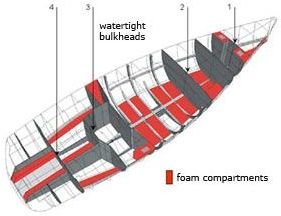

This is a ply epoxy boat so you have two options: air filled buoyancy chambers that have pressure equalizing valves and inspection hatches for ventilation when in port, or foam that is completley glued to the ply on all sides. Bulkhead watertight compartments were invented by the Chinese in approximately 200BC. The difference between the two is that merchant ships (as in cruise ships) cannot have watertight decks and bulkheads to their compartments as this restricts movement through the passenger accommodation. so devised or planned as to be impossible. Arrives by Thu, Aug 18 Buy Diagram Of The Sinking Titanic With The Forward Six Watertight Compartments Breached By Damage From Colliding With An Iceberg. If you don't want to go trough this exercise additional watertight compartments are just wasted work. WT compartments do of course incorporate WT bulkheads - normally transverse ones in merchant ships, longitudinal and transverse in warships. watertight constructed or fitted so tightly as to be impervious to water:The ship had six watertight compartments. You would have to actually model the swamped condition for different scenarios like "hole in the hull" or "front of ama/waka ripped off after collision" to see how it will float. I only see the need for those if you want the boat to be sailable when swamped, in wich case you have to arrange them so as to mentain a level attitude, wich probably means giving up some space in the bilges and under the setees. ON SHARP EDGES AND WATERTIGHT COMPARTMENTS : PROBLEMS OF LANGUAGE PLANNING IN THE SOUTtl AFRICAN CONTEXT. Additional watertight compartments can be installed into the structure but will only work if they are not pierced, otherwise they have to be filled with foam.

#Watertight compartments full#
The two existing full bulkheads are under the crossarms, they serve primarily to tie those to the structure and only secondarily as crash bulkheads. This is a plywood multihull, it should be unsinkable by design.


 0 kommentar(er)
0 kommentar(er)
